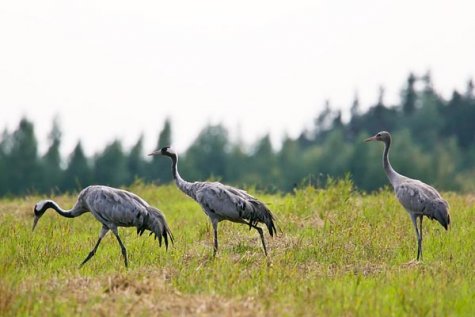Cranes seen and heard
Photo: Arne Ader
Translation: Liis
Crane family
Crane; Common crane; Eurasian crane Sookurg Grus grus
The migration of cranes started in August and lasts until November. At the moment the birds breeding here gather but in September migrants from the north as well as from north-east arrive here.
The large, grey-feathered adults have a red patch on the crown, a white streak runs from the eye to the neck. The wing primaries and the feet are black, the beak greenish-brown. The bushy tail plumage of the adults consists of decorative plumes – length over a meter -, the wing span is two and a half meters and the weight is about five to six kilos. The juveniles are still a little smaller than the adults, with a little lighter plumage, the head brownish.
The call is a far-reaching resounding trumpeting, mixed with the loud peeping of this summer’s young birds.
The crane is an ancient breeder in Estonia (around seven thousand pairs) and a passing migrant, there are tens of thousands of the latter. The migrants fly in "crane triangles", where one leg is often longer than the other. Estonia has more than thirty identified and well known stopping places for cranes on autumn migration – in the surroundings of Matsalu bay and West Estonia and also the Lahemaa area and East Estonia.
The diet of cranes consists of berries as well as frogs and reptiles. The migrants forage on large harvested corn fields both on what has spilled from the seeds and the mice feasting there, and sometimes potato fields are visited too. The night locations can be quite far from the foraging areas.
In Europe cranes winter in Spain and Turkey, in Africa in the northern and eastern parts.









